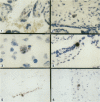Abstract
AIMS: To show the presence of HIV infected cells in the placentas and membranes exposed to HIV during pregnancy, and to trace the possible transmission routes from mother to fetus. METHODS: Twenty three therapeutic abortions and 11 term placentas were investigated for the presence of HIV antigen by immunostaining with HIV core protein specific antibodies and HIV nucleic acids by in situ hydridisation (ISH) with a 35S-labelled HIV specific RNA probe. RESULTS: HIV antigen as well as HIV RNA positive cells were rarely found in placental tissue and membranes. In therapeutic abortions HIV antigen was shown in 10 out of 23 placentas, HIV RNA in two. HIV antigen was detected in five out of 11 term placentas and HIV RNA in two. Infected cell types comprised syncytiotrophoblasts, Hofbauer cells, amnionic epithelium, chorionic macrophages as well as maternal lymphocytes in the intervillous space and decidua. CONCLUSION: These data suggest that the transmission routes are: (1) a haematogenous route from the maternal intervillous space to villous stromal cells; (2) from chorion laeve to amnionic fluid and vice versa. Two additional transmission routes are partly suggested by the data: (1) in early gestation by direct extension from basal decidua to budding trophoblastic cells; (2) from the capsular decidua to chorion laeve and chorionic plate, entering the fetal circulation via the small veins.
Full text
PDF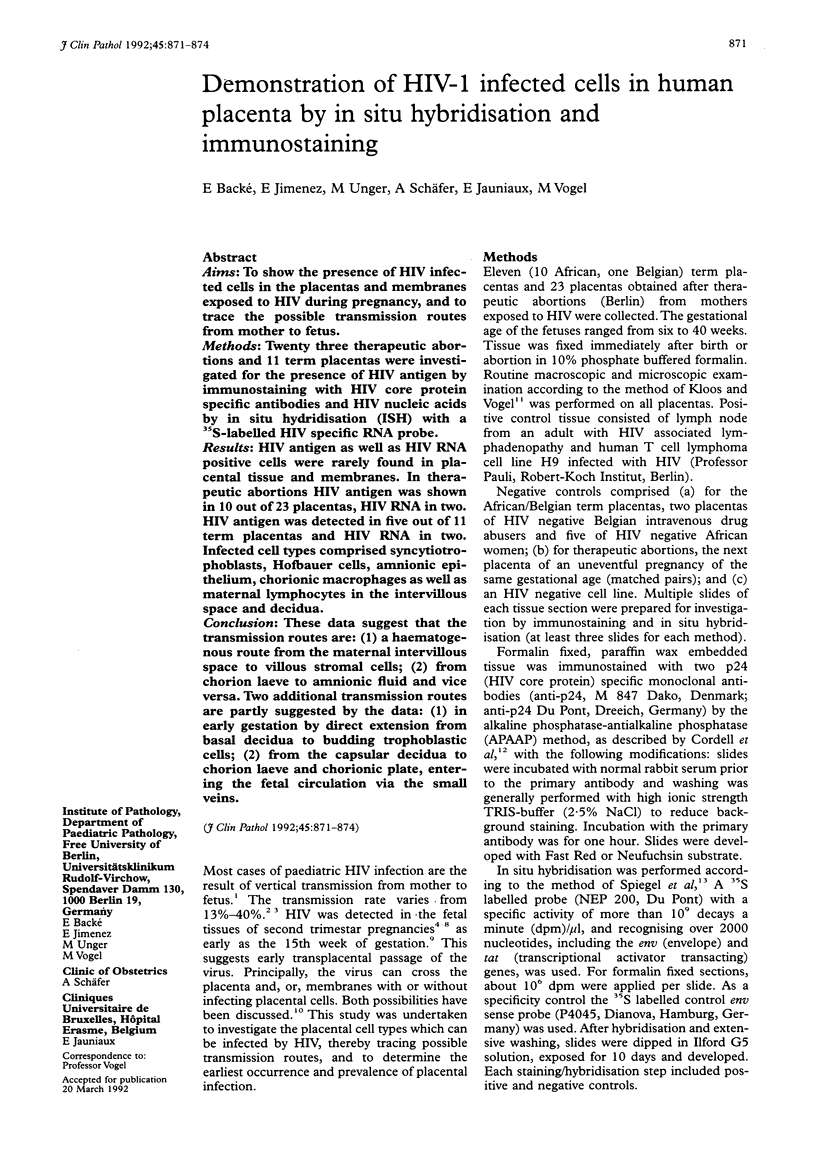
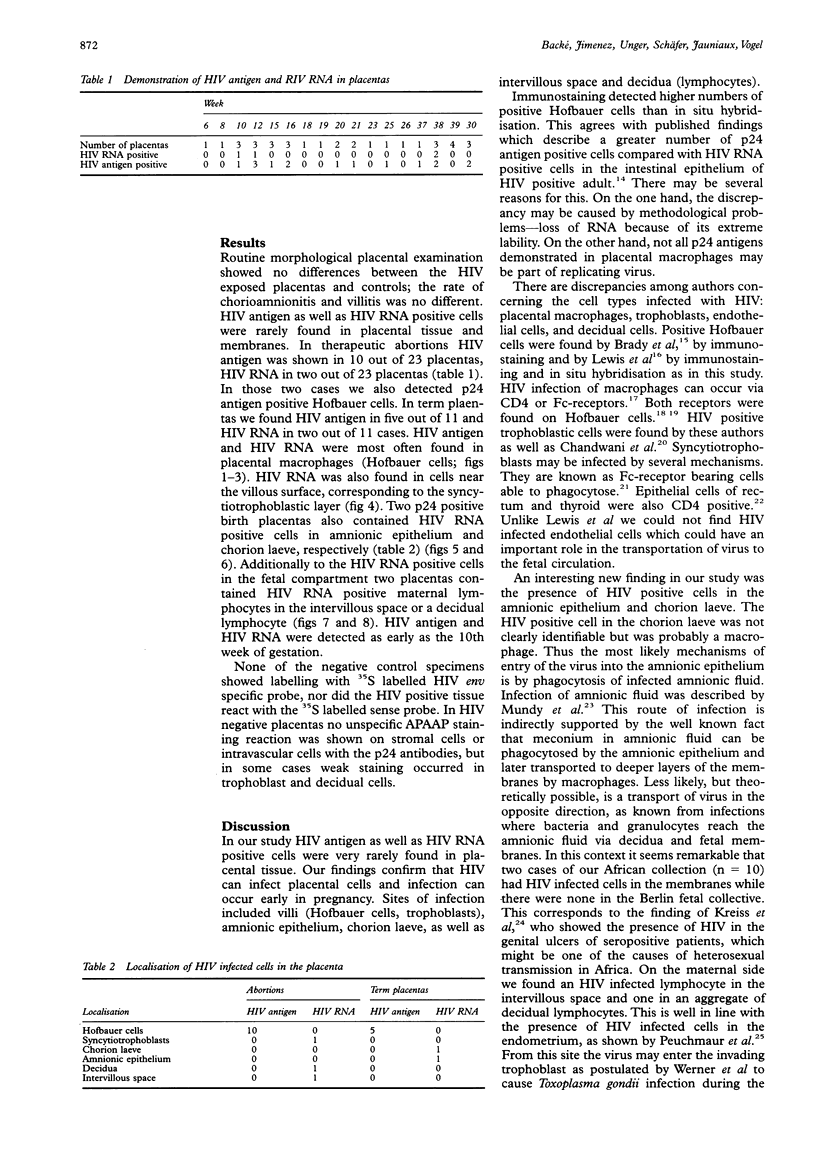
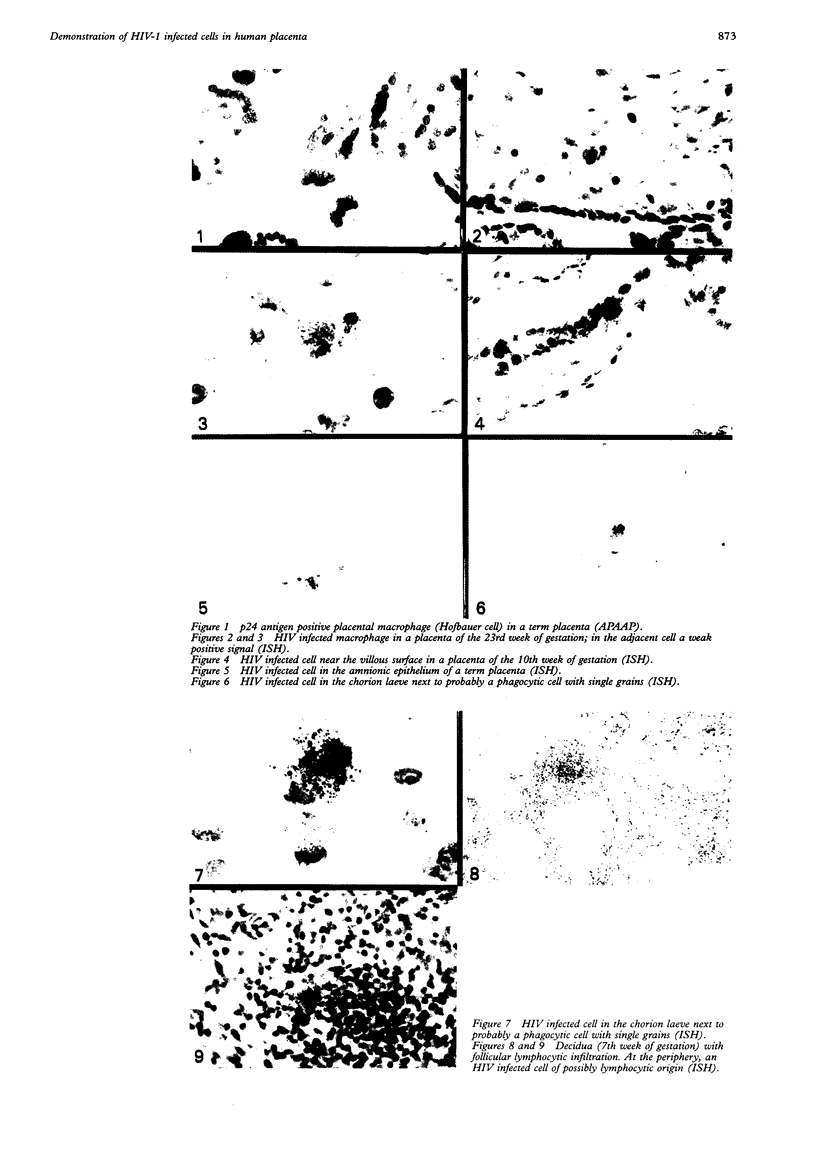
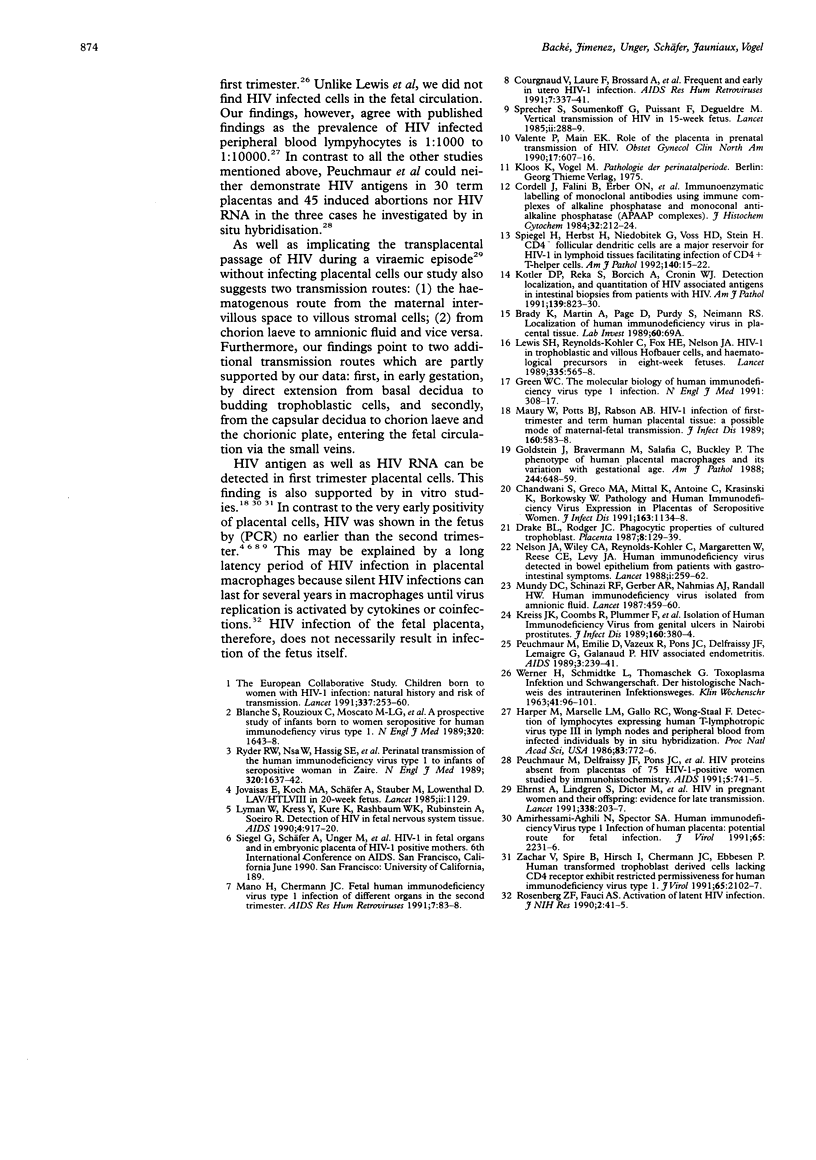
Images in this article
Selected References
These references are in PubMed. This may not be the complete list of references from this article.
- Amirhessami-Aghili N., Spector S. A. Human immunodeficiency virus type 1 infection of human placenta: potential route for fetal infection. J Virol. 1991 May;65(5):2231–2236. doi: 10.1128/jvi.65.5.2231-2236.1991. [DOI] [PMC free article] [PubMed] [Google Scholar]
- Blanche S., Rouzioux C., Moscato M. L., Veber F., Mayaux M. J., Jacomet C., Tricoire J., Deville A., Vial M., Firtion G. A prospective study of infants born to women seropositive for human immunodeficiency virus type 1. HIV Infection in Newborns French Collaborative Study Group. N Engl J Med. 1989 Jun 22;320(25):1643–1648. doi: 10.1056/NEJM198906223202502. [DOI] [PubMed] [Google Scholar]
- Colombo M., Mannucci P. M., Carnelli V., Savidge G. F., Gazengel C., Schimpf K. Transmission of non-A, non-B hepatitis by heat-treated factor VIII concentrate. Lancet. 1985 Jul 6;2(8445):1–4. doi: 10.1016/s0140-6736(85)90055-8. [DOI] [PubMed] [Google Scholar]
- Courgnaud V., Lauré F., Brossard A., Bignozzi C., Goudeau A., Barin F., Bréchot C. Frequent and early in utero HIV-1 infection. AIDS Res Hum Retroviruses. 1991 Mar;7(3):337–341. doi: 10.1089/aid.1991.7.337. [DOI] [PubMed] [Google Scholar]
- Drake B. L., Rodger J. C. Phagocytic properties of cultured murine trophoblast. Placenta. 1987 Mar-Apr;8(2):129–139. doi: 10.1016/0143-4004(87)90016-6. [DOI] [PubMed] [Google Scholar]
- Ehrnst A., Lindgren S., Dictor M., Johansson B., Sönnerborg A., Czajkowski J., Sundin G., Bohlin A. B. HIV in pregnant women and their offspring: evidence for late transmission. Lancet. 1991 Jul 27;338(8761):203–207. doi: 10.1016/0140-6736(91)90347-r. [DOI] [PubMed] [Google Scholar]
- Goldstein J., Braverman M., Salafia C., Buckley P. The phenotype of human placental macrophages and its variation with gestational age. Am J Pathol. 1988 Dec;133(3):648–659. [PMC free article] [PubMed] [Google Scholar]
- Greene W. C. The molecular biology of human immunodeficiency virus type 1 infection. N Engl J Med. 1991 Jan 31;324(5):308–317. doi: 10.1056/NEJM199101313240506. [DOI] [PubMed] [Google Scholar]
- Harper M. E., Marselle L. M., Gallo R. C., Wong-Staal F. Detection of lymphocytes expressing human T-lymphotropic virus type III in lymph nodes and peripheral blood from infected individuals by in situ hybridization. Proc Natl Acad Sci U S A. 1986 Feb;83(3):772–776. doi: 10.1073/pnas.83.3.772. [DOI] [PMC free article] [PubMed] [Google Scholar]
- Kotler D. P., Reka S., Borcich A., Cronin W. J. Detection, localization, and quantitation of HIV-associated antigens in intestinal biopsies from patients with HIV. Am J Pathol. 1991 Oct;139(4):823–830. [PMC free article] [PubMed] [Google Scholar]
- Kreiss J. K., Coombs R., Plummer F., Holmes K. K., Nikora B., Cameron W., Ngugi E., Ndinya Achola J. O., Corey L. Isolation of human immunodeficiency virus from genital ulcers in Nairobi prostitutes. J Infect Dis. 1989 Sep;160(3):380–384. doi: 10.1093/infdis/160.3.380. [DOI] [PubMed] [Google Scholar]
- Lewis S. H., Reynolds-Kohler C., Fox H. E., Nelson J. A. HIV-1 in trophoblastic and villous Hofbauer cells, and haematological precursors in eight-week fetuses. Lancet. 1990 Mar 10;335(8689):565–568. doi: 10.1016/0140-6736(90)90349-a. [DOI] [PubMed] [Google Scholar]
- Lyman W. D., Kress Y., Kure K., Rashbaum W. K., Rubinstein A., Soeiro R. Detection of HIV in fetal central nervous system tissue. AIDS. 1990 Sep;4(9):917–920. doi: 10.1097/00002030-199009000-00014. [DOI] [PubMed] [Google Scholar]
- Mano H., Chermann J. C. Fetal human immunodeficiency virus type 1 infection of different organs in the second trimester. AIDS Res Hum Retroviruses. 1991 Jan;7(1):83–88. doi: 10.1089/aid.1991.7.83. [DOI] [PubMed] [Google Scholar]
- Maury W., Potts B. J., Rabson A. B. HIV-1 infection of first-trimester and term human placental tissue: a possible mode of maternal-fetal transmission. J Infect Dis. 1989 Oct;160(4):583–588. doi: 10.1093/infdis/160.4.583. [DOI] [PubMed] [Google Scholar]
- Mundy D. C., Schinazi R. F., Gerber A. R., Nahmias A. J., Randall H. W., Jr Human immunodeficiency virus isolated from amniotic fluid. Lancet. 1987 Aug 22;2(8556):459–460. doi: 10.1016/s0140-6736(87)91001-4. [DOI] [PubMed] [Google Scholar]
- Nelson J. A., Wiley C. A., Reynolds-Kohler C., Reese C. E., Margaretten W., Levy J. A. Human immunodeficiency virus detected in bowel epithelium from patients with gastrointestinal symptoms. Lancet. 1988 Feb 6;1(8580):259–262. doi: 10.1016/s0140-6736(88)90348-0. [DOI] [PubMed] [Google Scholar]
- Peuchmaur M., Delfraissy J. F., Pons J. C., Emilie D., Vazeux R., Rouzioux C., Brossard Y., Papiernik E. HIV proteins absent from placentas of 75 HIV-1-positive women studied by immunohistochemistry. AIDS. 1991 Jun;5(6):741–745. doi: 10.1097/00002030-199106000-00015. [DOI] [PubMed] [Google Scholar]
- Peuchmaur M., Emilie D., Vazeux R., Pons J. C., Delfraissy J. F., Lemaigre G., Galanaud P. HIV-associated endometritis. AIDS. 1989 Apr;3(4):239–241. doi: 10.1097/00002030-198904000-00008. [DOI] [PubMed] [Google Scholar]
- Ryder R. W., Nsa W., Hassig S. E., Behets F., Rayfield M., Ekungola B., Nelson A. M., Mulenda U., Francis H., Mwandagalirwa K. Perinatal transmission of the human immunodeficiency virus type 1 to infants of seropositive women in Zaire. N Engl J Med. 1989 Jun 22;320(25):1637–1642. doi: 10.1056/NEJM198906223202501. [DOI] [PubMed] [Google Scholar]
- Spiegel H., Herbst H., Niedobitek G., Foss H. D., Stein H. Follicular dendritic cells are a major reservoir for human immunodeficiency virus type 1 in lymphoid tissues facilitating infection of CD4+ T-helper cells. Am J Pathol. 1992 Jan;140(1):15–22. [PMC free article] [PubMed] [Google Scholar]
- Sprecher S., Soumenkoff G., Puissant F., Degueldre M. Vertical transmission of HIV in 15-week fetus. Lancet. 1986 Aug 2;2(8501):288–289. doi: 10.1016/s0140-6736(86)92110-0. [DOI] [PubMed] [Google Scholar]
- Valente P., Main E. K. Role of the placenta in perinatal transmission of HIV. Obstet Gynecol Clin North Am. 1990 Sep;17(3):607–616. [PubMed] [Google Scholar]
- WERNER H., SCHMIDTKE L., THOMASCHECK G. [Toxoplasma infection and pregnancy. Histologic demonstration of the intrauterine route of infection]. Klin Wochenschr. 1963 Jan 15;41:96–101. doi: 10.1007/BF01583744. [DOI] [PubMed] [Google Scholar]



